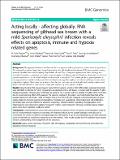Por favor, use este identificador para citar o enlazar a este item:
http://hdl.handle.net/10261/178043COMPARTIR / EXPORTAR:
 SHARE SHARE
 CORE
BASE CORE
BASE
|
|
| Visualizar otros formatos: MARC | Dublin Core | RDF | ORE | MODS | METS | DIDL | DATACITE | |

| Título: | Acting locally - affecting globally: RNA sequencing of gilthead sea bream with a mild Sparicotyle chrysophrii infection reveals effects on apoptosis, immune and hypoxia related genes |
Autor: | Piazzon de Haro, María Carla CSIC ORCID ; Mladineo, Ivona; Naya-Català, Fernando CSIC ORCID; Dirks, Ron P.; Jong-Raadsen, Susanne; Vrbatović, Anamarija; Hrabar, Jerko; Pérez-Sánchez, Jaume CSIC ORCID; Sitjà-Bobadilla, Ariadna CSIC ORCID | Palabras clave: | Sparus aurata Sparicotyle chrysophrii Gills Monogenea Ectoparasites Illumina RNA-seq Transcriptomics Apoptosis Immune response |
Fecha de publicación: | 11-mar-2019 | Editor: | BioMed Central | Citación: | BMC Genomics 20(1): 200 (2019) | Resumen: | [Background] Monogenean flatworms are the main fish ectoparasites inflicting serious economic losses in aquaculture. The polyopisthocotylean Sparicotyle chrysophrii parasitizes the gills of gilthead sea bream (GSB, Sparus aurata) causing anaemia, lamellae fusion and sloughing of epithelial cells, with the consequent hypoxia, emaciation, lethargy and mortality. Currently no preventive or curative measures against this disease exist and therefore information on the host-parasite interaction is crucial to find mitigation solutions for sparicotylosis. The knowledge about gene regulation in monogenean-host models mostly comes from freshwater monopysthocotyleans and almost nothing is known about polyopisthocotyleans. The current study aims to decipher the host response at local (gills) and systemic (spleen, liver) levels in farmed GSB with a mild natural S. chrysophrii infection by transcriptomic analysis. [Results] Using Illumina RNA sequencing and transcriptomic analysis, a total of 2581 differentially expressed transcripts were identified in infected fish when compared to uninfected controls. Gill tissues in contact with the parasite (P gills) displayed regulation of fewer genes (700) than gill portions not in contact with the parasite (NP gills) (1235), most likely due to a local silencing effect of the parasite. The systemic reaction in the spleen was much higher than that at the parasite attachment site (local) (1240), and higher than in liver (334). NP gills displayed a strong enrichment of genes mainly related to immune response and apoptosis. Processes such as apoptosis, inflammation and cell proliferation dominated gills, whereas inhibition of apoptosis, autophagy, platelet activation, signalling and aggregation, and inflammasome were observed in spleen. Proteasome markers were increased in all tissues, whereas hypoxia-related genes were down-regulated in gills and spleen. [Conclusions] Contrasting forces seem to be acting at local and systemic levels. The splenic down-regulation could be part of a hypometabolic response, to counteract the hypoxia induced by the parasite damage to the gills and to concentrate the energy on defence and repair responses. Alternatively, it can be also interpreted as the often observed action of helminths to modify host immunity in its own interest. These results provide the first toolkit for future studies towards understanding and management of this parasitosis. |
Versión del editor: | https://doi.org/10.1186/s12864-019-5581-9 | URI: | http://hdl.handle.net/10261/178043 | DOI: | 10.1186/s12864-019-5581-9 | E-ISSN: | 1471-2164 |
| Aparece en las colecciones: | (IATS) Artículos |
Ficheros en este ítem:
| Fichero | Descripción | Tamaño | Formato | |
|---|---|---|---|---|
| RNA_gilthead_sea_bream_mild_Sparicotyle_chrysophrii_infection.pdf | 2,72 MB | Adobe PDF |  Visualizar/Abrir |
CORE Recommender
PubMed Central
Citations
9
checked on 29-feb-2024
SCOPUSTM
Citations
24
checked on 17-abr-2024
WEB OF SCIENCETM
Citations
22
checked on 26-feb-2024
Page view(s)
412
checked on 19-abr-2024
Download(s)
282
checked on 19-abr-2024

